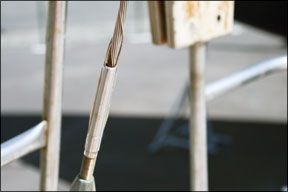Over the years, I’ve heard various timeframes for when to replace standing rigging, but I’ve never seen any empirical data to back up those recommendations. It would be very informative to know from a metallurgical/metal failure point of view estimated lifespans of the average wire used for standing

Photo courtesy of Mahina Expeditions (www.mahina.com)
288
rigging.
Kevin May
Via e-mail
The guidelines offered by wire manufacturers and the U.S. Coast Guard are supported by engineering tests and data collected in the field, but it can be misleading to say you only need to replace your wire every “xx” years.
According to the U.S. Coast Guard: “The service life of sail rigging varies according to each vessel’s design characteristics, and may depend on multiple variables.” Factors like how the boat is used and how often, environmental conditions, materials quality, engineered safety factors, installation, maintenance regimen, etc., all affect the durability of the rigging.
Rigging on an ocean racing boat that sees a lot of regular hard use will not last as long as that of a cruising boat that spends a lot of time at anchor. Similarly, boats exposed to acid rain, salt water, and heavy air pollution will see faster degradation.
Stainless-steel wire rigging shares the same vulnerabilities of other stainless hardware on deck. (For a look at the bad surprises marine metals can hide, check out “Keep a Close Watch on Marine Metals,” February 2007.) On the good side, individual wire strands typically fail before the wire itself, offering an early warning.
While there’s no hard and fast rule for wire replacement, we generally recommend 10-12 years for wire on an average cruising boat. This assumes all terminals and end fittings are also up to snuff. Complete inspections—including terminals and end fittings—should be carried out every six years or 40,000-60,000 miles, whichever comes first, according to Navtec Rigging Solutions, the company that outfits America’s Cup rigs.
Deck-level swage fittings are often a weak point. Other trouble spots include misalignment (or no toggles to allow for rig mast movement), mismatched clevis pins, and an improperly tuned rig. All of these can throw any life-span figure out the window.
A recent dismasting of a 60-foot inspected passenger-carrying sailing catamaran in the Florida Keys highlights the dire need to regularly inspect your rigging. The accident prompted a U.S . Coast Guard safety alert regarding sailboat rigging: “Evidence suggests that the port shroud parted where it exits a swageless mechanical end fitting located on the upper mast at a common shrouds/stay connection. … Initial forensic metallurgical analysis of the failed cable strands showed visual corrosion and evidence of fatigue failure. The shroud cable and swageless end fitting had been installed seven years prior…”
Following a spate of similar rig failures on passenger cats in Hawaii, some fatal, the Coast Guard issued a notice (Sector Honolulu Inspection Note No. 13) outlining its inspection guidelines for rigging, masts, and associated hardware. The notice, which was developed with input from marine surveyors and rigging manufacturers, urges regular inspections and gives a basic timeline for replacing shrouds.
You can find the notice online with this article at www.practical-sailor.com or at homeport.uscg.mil/mycg/portal/ep/contentView.do?order=desc&contentOID=109624&contentId=109624&programId=12586&contentType=EDITORIAL.
For more information on rig inspection and service life, check out www.navtec.net/docs/RiggingService.pdf and www.dixielandmarine.com/yachts/DLrigprob.html.







































